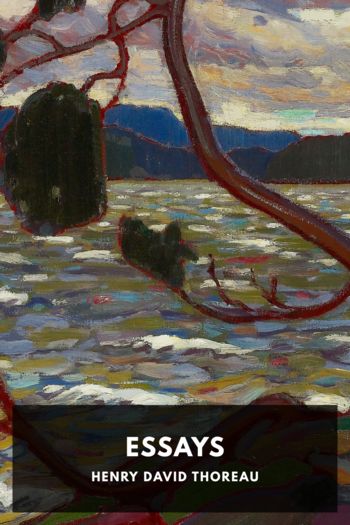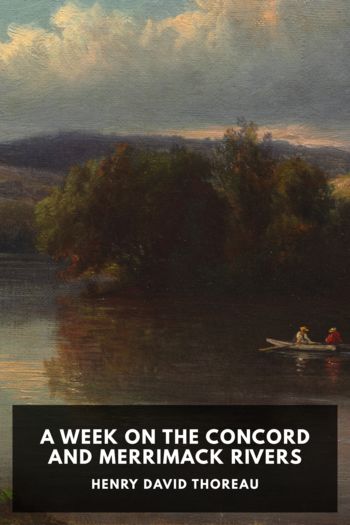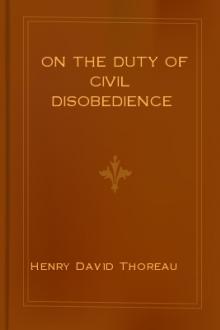Essays by Henry David Thoreau (feel good books .txt) 📕

Description
Though perhaps most famous for Walden, Henry David Thoreau was also a prolific essayist. Many of his essays touch on subjects similar to his famous book: long walks through nature, things found in moonlight that are invisible and unheard during the day, his preference for wild apples over domestic ones. In many ways he prefigured environmentalism, expressing his love for untouched nature and lamenting what the encroachment of man and cities were doing to it.
He also had strong opinions on many other subjects. One of his most famous essays, “On the Duty of Civil Disobedience,” was written as a result of his going to jail for refusing to pay several years’ worth of poll taxes. One of the primary reasons for his refusal was his holding the government in contempt for its support of slavery, and several of his other essays express support and admiration for John Brown, who thought to start a slave revolt when he attacked Harper’s Ferry in 1859.
Whether discussing trees in a forest, slavery, or the works of Thomas Carlyle, Thoreau’s essays are deeply personal and full of keen observations, often in poetic language. They give a sense of the man expressing them as being much more than the views being expressed.
Read free book «Essays by Henry David Thoreau (feel good books .txt) 📕» - read online or download for free at americanlibrarybooks.com
- Author: Henry David Thoreau
Read book online «Essays by Henry David Thoreau (feel good books .txt) 📕». Author - Henry David Thoreau
The road, in this clayey looking soil, was exceedingly muddy in consequence of the night’s rain. We met an old woman directing her dog, which was harnessed to a little cart, to the least muddy part of it. It was a beggarly sight. But harnessed to the cart as he was, we heard him barking after we had passed, though we looked anywhere but to the cart to see where the dog was that barked. The houses commonly fronted the south, whatever angle they might make with the road; and frequently they had no door nor cheerful window on the roadside. Half the time they stood fifteen to forty rods from the road, and there was no very obvious passage to them, so that you would suppose that there must be another road running by them. They were of stone, rather coarsely mortared, but neatly whitewashed, almost invariably one story high and long in proportion to their height, with a shingled roof, the shingles being pointed, for ornament, at the eaves, like the pickets of a fence, and also one row halfway up the roof. The gables sometimes projected a foot or two at the ridgepole only. Yet they were very humble and unpretending dwellings. They commonly had the date of their erection on them. The windows opened in the middle, like blinds, and were frequently provided with solid shutters. Sometimes, when we walked along the back side of a house which stood near the road, we observed stout stakes leaning against it; by which the shutters, now pushed half open, were fastened at night; within, the houses were neatly ceiled with wood not painted. The oven was commonly out of doors, built of stone and mortar, frequently on a raised platform of planks. The cellar was often on the opposite side of the road, in front of or behind the houses, looking like an icehouse with us with a lattice door for summer. The very few mechanics whom we met had an old-Bettyish look, in their aprons and bonnets rouges, like fools’ caps. The men wore commonly the same bonnet rouge, or red woollen or worsted cap, or sometimes blue or gray, looking to us as if they had got up with their nightcaps on, and, in fact, I afterwards found that they had. Their clothes were of the cloth of the country, étoffe du pays, gray or some other plain color. The women looked stout, with gowns that stood out stiffly, also, for the most part, apparently of some homemade stuff. We also saw some specimens of the more characteristic winter dress of the Canadian, and I have since frequently detected him in New England by his coarse gray homespun capote and picturesque red sash, and his well-furred cap, made to protect his ears against the severity of his climate.
It drizzled all day, so that the roads did not improve. We began now to meet with wooden crosses frequently, by the roadside, about a dozen feet high, often old and toppling down, sometimes standing in a square wooden platform, sometimes in a pile of stones, with a little niche containing a picture of the Virgin and Child, or of Christ alone, sometimes with a string of beads, and covered with a piece of glass to keep out the rain, with the words, pour la vierge, or Iniri, on them. Frequently, on the crossbar, there would be quite a collection of symbolical knickknacks, looking like an Italian’s board; the representation in wood of a hand, a hammer, spikes, pincers, a flask of vinegar, a ladder, etc., the whole, perchance, surmounted by a weathercock; but I could not look at an honest weathercock in this walk without mistrusting that there was some covert reference in it to St. Peter. From time to time we passed a little one-story chapel-like building, with a tin-roofed spire, a shrine, perhaps it would be called, close to the pathside, with a lattice door, through which we could see an altar, and pictures about the walls; equally open, through rain and shine, though there was no getting into it. At these places the inhabitants kneeled and perhaps breathed a short prayer. We saw one schoolhouse in our walk, and listened to the sounds which issued from it; but it appeared like a place where the process, not of enlightening, but of obfuscating the mind was going on, and the pupils received only so much light as could penetrate the shadow of the Catholic Church. The churches were very picturesque, and their interior much more showy than the dwelling-houses promised. They were of stone, for it was ordered, in 1699, that that should be their material. They had tinned spires, and quaint ornaments. That of l’Ange Gardien had a dial on it, with the Middle Age Roman numerals on its face, and some images in niches on the outside. Probably its counterpart has existed in Normandy for a thousand years. At the church of Château Richer, which is the next parish to l’Ange Gardien, we read, looking over the wall, the inscriptions in the adjacent churchyard, which began with, “Ici git” or “Repose,” and one over a boy contained, “Priez pour lui.” This answered as well as Père la Chaise. We knocked at the door of the curé’s house here, when a sleek friar-like personage, in his sacerdotal robe, appeared. To our Parlez-vous Anglais? even he answered, “Non, Monsieur”; but at last we made him understand what we wanted. It was to find the ruins of the old château. “Ah! oui! oui!” he exclaimed, and, donning his coat, hastened forth, and conducted us to a small heap of rubbish which we had already examined. He said that fifteen years before, it





Comments (0)